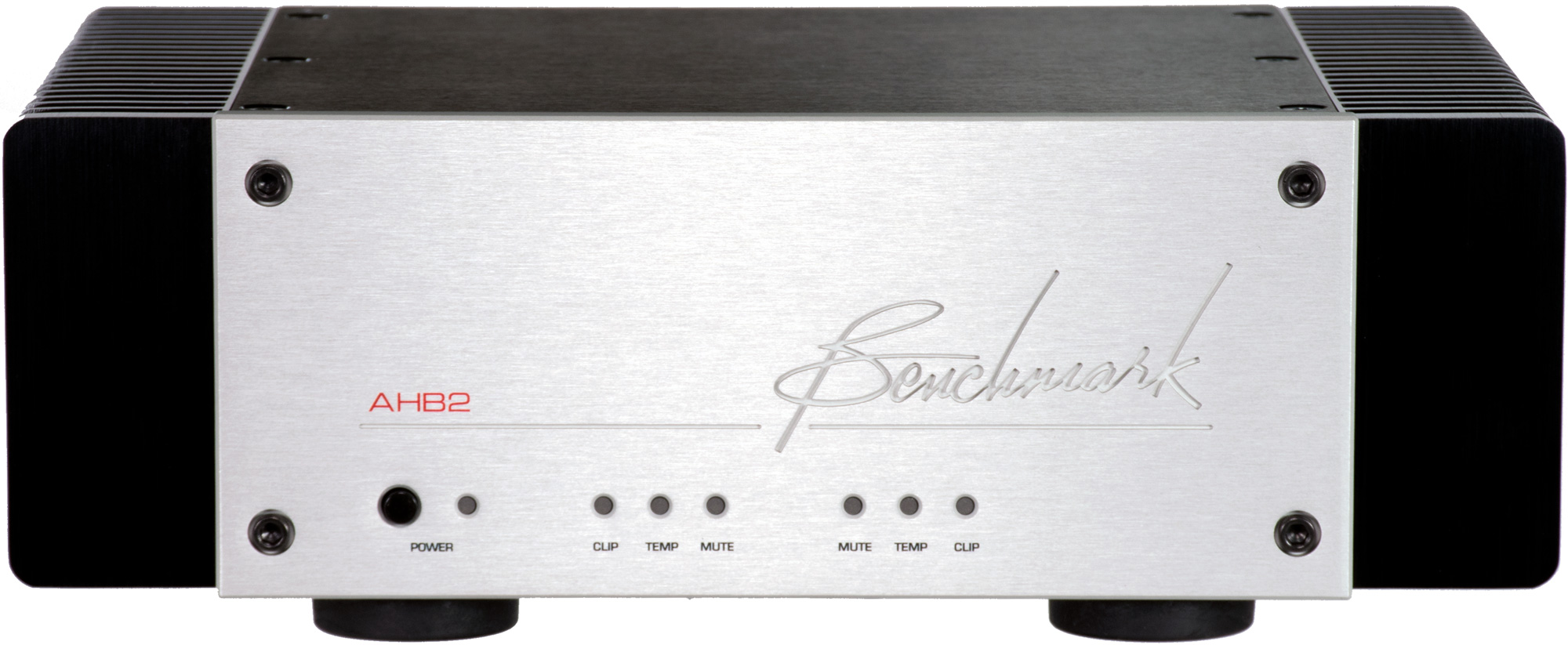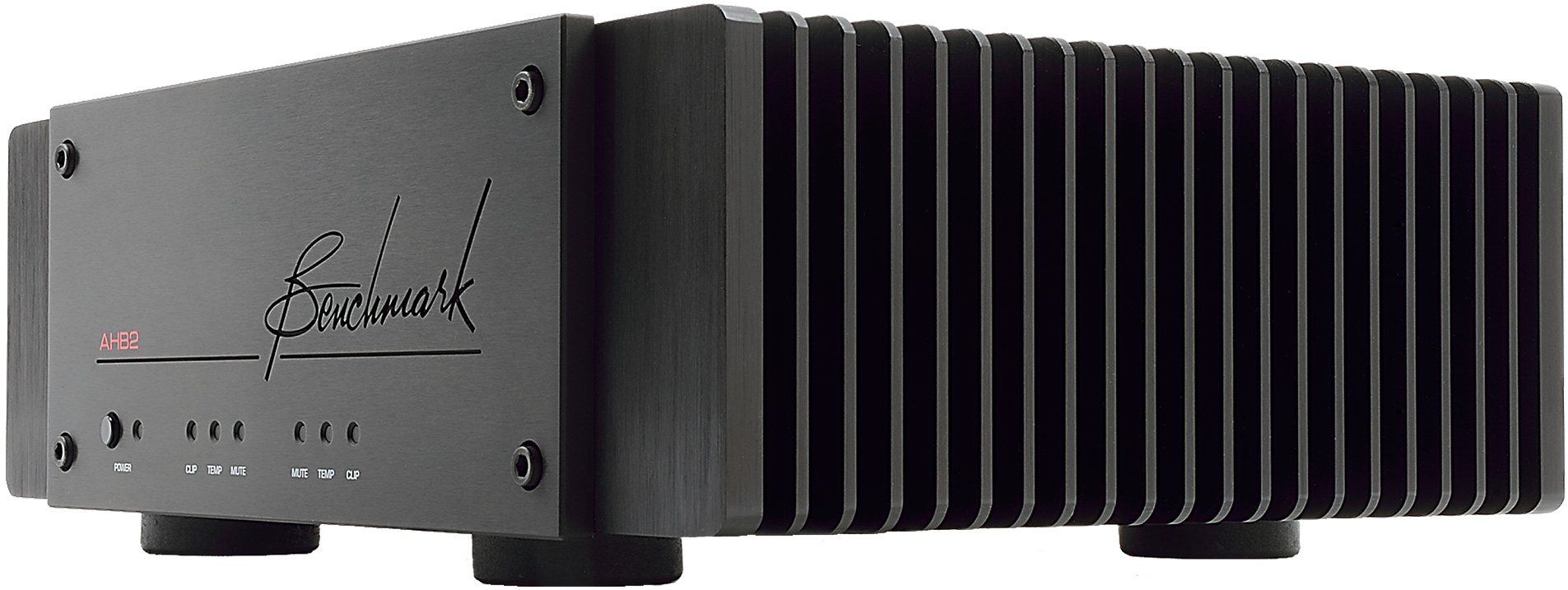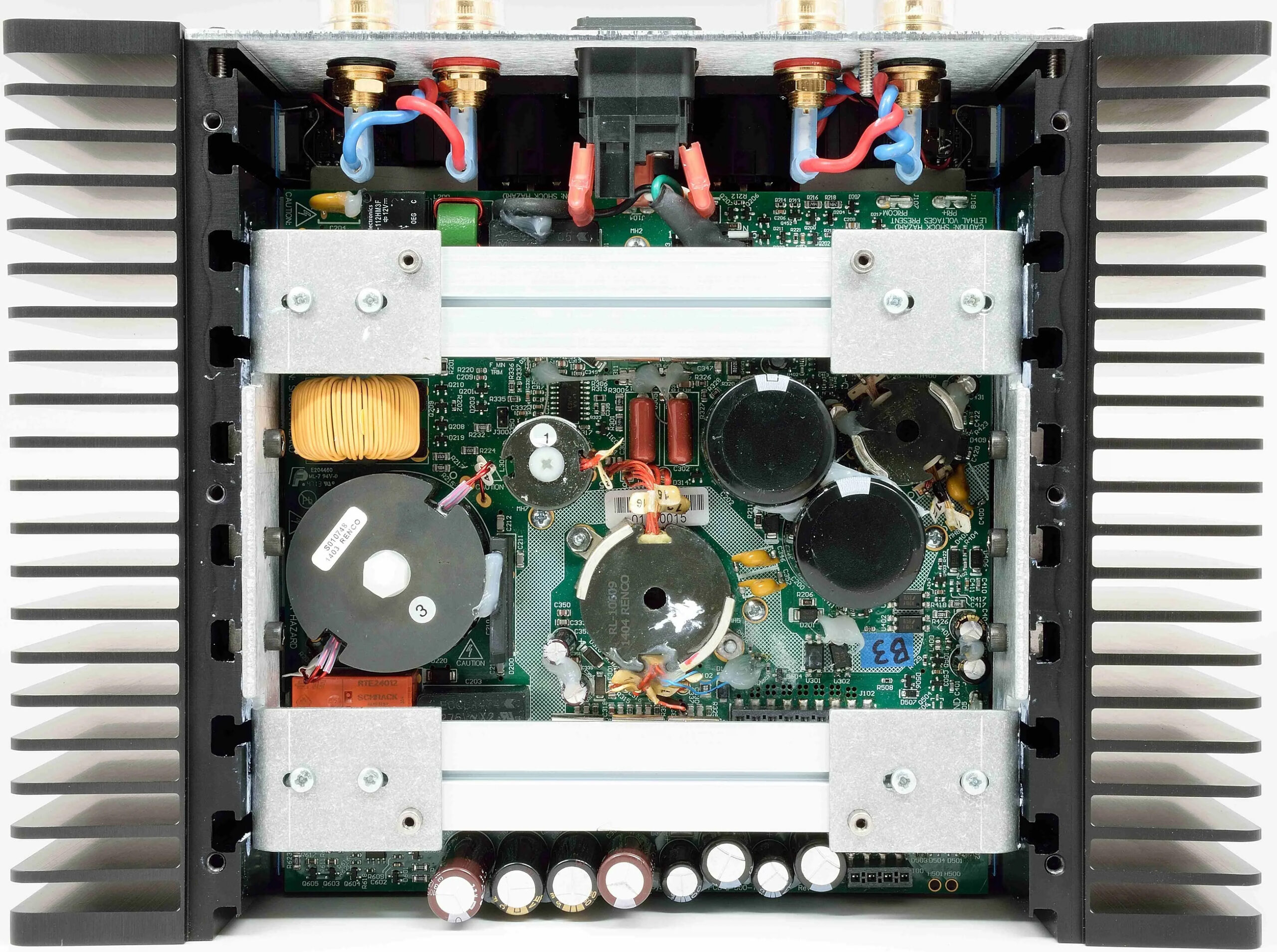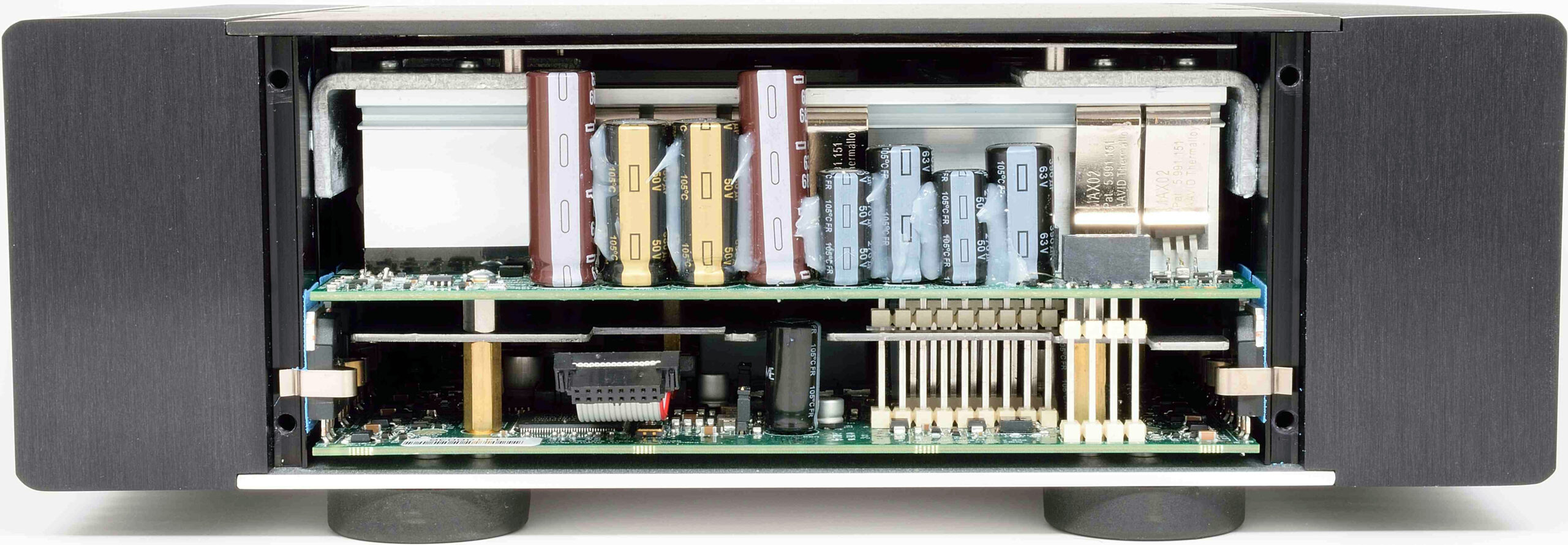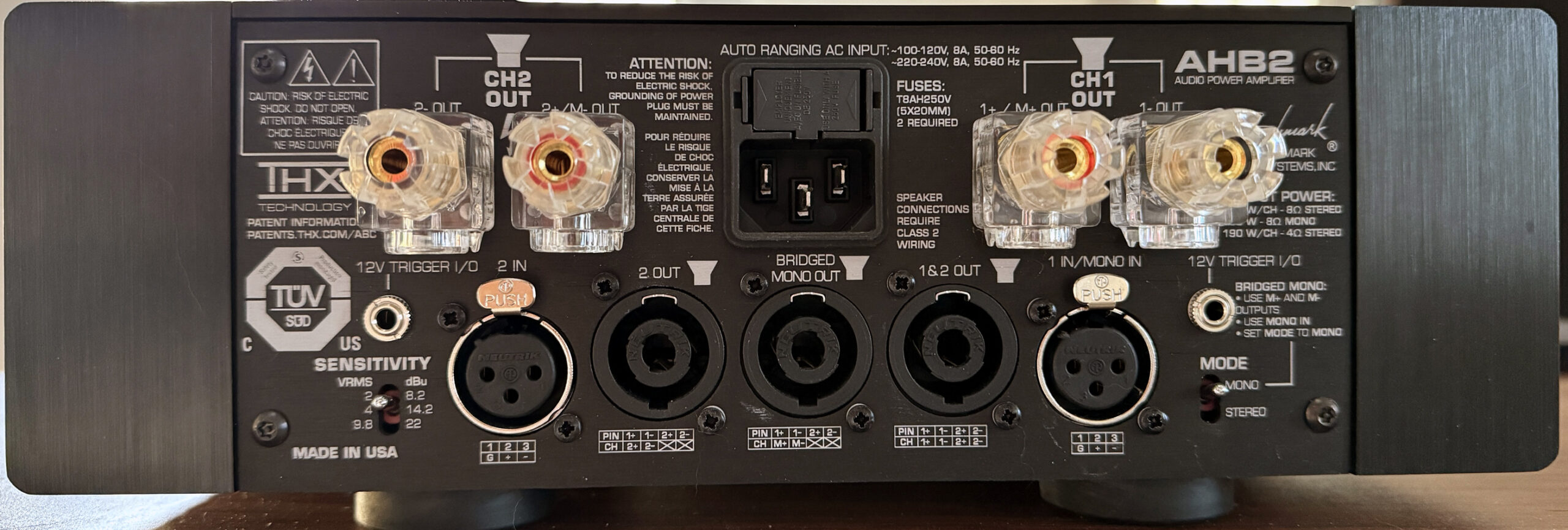Benchmark Media is known for its small-footprint digital-to-analog converters such as the discontinued DAC2 and current-production DAC3 series, as well as analog-to-digital converters. The AHB2 bridgeable stereo amplifier, a pair of which being the subject of this review, was first introduced in the fall of 2014, and was the topic of a recent discussion between American electrostatic panel speaker manufacturer Sound Lab’s president, Dr. Roger West, and me.
Dr. West knows well of my choice of reference amplifiers for driving the company’s Majestic 645 electrostatic panels in my home, namely the pure class A Pass Laboratories XA200.8 monoblocks and the class A/AB Bricasti Design M28 monoblocks. In our discussion, he related his highly positive experience in driving even his largest, $55k Majestic 945 panels with the $7,000 pair of Benchmark Media AHB2 monoblocks, along with the $3,050 L4 Preamplifier and factory XLR cables. He suggested that I review the system, and Benchmark Media Sales Manager Rory Rall sent an entire system to me. After initial auditioning, I decided to focus on just the pair of AHB2 monoblocks.
I have always harbored a fascination for amplifiers of modest physique, all the way back to the Monarchy Audio SM70Pro class A monoblocks. They were superb in the midrange to top-end, so much so that as to make envious even competition many times their asking price. Yet, they only delivered a hundred watts per channel. Equipped with eight bipolar transistors per channel, the Benchmark Media AHB2 is of similar stature but with technical innovation on a whole different level, namely the incorporation of the patented THX Achromatic Audio Amplifier Technology (THX AAA). THX is a cinematic sound certification program that certifies electronics and speakers that conform to its standards in sound reproduction. Never has the program been designed for use in strictly two-channel home stereo systems.
Dr. West described the AHB2 as a class AB design using “feed-forward distortion reduction [thus removing] any possibility of pushing the margin of safety of a standard feedback loop, used in most amplifiers, into an unstable oscillatory mode.” He further shared with me that “this is of most concern on powerful musical transients. The distortion of the amplifier in the balanced mode is astonishingly low even at just below the clipping level of 380 watts.” What the good doctor might not have realized is, when I am feeling gleeful, the insane levels to which I never subject any other speakers except his panels.
The bridged, reviewed pair is rated at an output of 380 watts into 8 ohms and 480 watts into 6 ohms.
In my correspondence with Per Patrick Jensen, THX Ltd Public Relations Intern, he explained: “There is a science behind THX Certification. THX engineers perform hundreds of tests to ensure sound and picture reproduction in the industry’s top entertainment equipment is fully preserved. Only the very best products with uncompromising quality, performance, and consistency become THX Certified. THX Certification is the assurance of uncompromising quality, consistency, and performance. It is the blend of art, technology, and the dynamics of real-world listening and viewing environments to ensure products deliver the artist’s true vision.”
THX AAA FEATURES
- Patented feed-forward error correction topology that nulls conventional distortion mechanisms.
- Reduction of harmonic, intermodulation, and crossover distortion by up to 40dB, resulting in a realistic and fatigue-free listening experience.
- Enables maximum output power for greater dynamic range and sound pressure level (SPL)
- A convenient modular solution which includes power supply and can operate from a single 3.6V battery.(Not applicable to the AHB2)
- Minimal bias current and highly efficient power management to optimize and extend device battery life.(Not applicable to the AHB2)
- Scalability that allows incorporation into any headphone or in-vehicle amplifier design, with the flexibility to match the required fidelity, output power, and price point.
THX AAA is claimed to be “the world’s most linear amplifier technology for headphones and in-vehicle audio systems,” and supposedly sets new standards in low noise, distortion and power consumption.
The speaker binding posts on the AHB2’s rear panel take spade and banana connectors, while there is also an opening for bare wire. The XLR input at the back of the AHB2 is situated beneath the positive and negative speaker connectors and at such proximity that it blocks thick speaker cables, such as the A.R.T. Analyst EVO, from a vertical bottom-up insertion. After months of auditioning several thin speaker cables of various manufacture, I found the very slender, $5,000 pair Audience AV frontRow in spade termination provided the most balanced suite of attributes with the system, and they fitted around the A.R.T. XLR cables. The amplifier’s input sensitivity was set at the first position of 8.2 dBu, or 2 VRMS as required for RCA inputs. The $16,000 Bricasti Design M21 dual-mono DSD DAC with its variable analog output served as the source.
The prospect of the AHB2’s specified distortion level of 0.00015% or lower when at full volume is comical at first glance, but upon actual audition the impact of the achievement is very audible from medium-high listening levels and upward. Driven as such when playing the HDtracks super-resolution file of the Proprius Cantate Domino, the 90 dB, 8 Ohm, six-feet tall Sound Lab Majestic 645 electrostatic panels produced a top-to-bottom tonal clarity resembling that from the Bricasti Design. In addition, the Sound Lab has the advantage of an enormous radiating surface that pumps out as much information as the system upstream can deliver, and the AHB2 did just that. It was unlike any other sub-$20,000 amplifier I have auditioned.
The factory cable set from Benchmark Media rendered mellow transients and pleasant tonalities, but it was with the A.R.T. Analyst XLRs, Super power cables, and the Audience frontRow speaker cables that its 380 watts per channel specification as bridged into mono translated into powerful pipe organ transients and extensions, exhibiting stunning dynamic transients and tonal differentiation approaching that of the $28k Bricasti Design M28 monoblocks. And the separation of the church choir was exemplary, which I assumed was achieved by virtue of the amplifiers’ very low distortion level. The Benchmark Media also provided ample ambience, albeit not transmitting a depth of field as expertly as the Bricasti Design.
Switching up to the newly delivered, $55,000 the pair Sound Lab Majestic 945 electrostatic panels put the AHB2 under noticeable stress. The opening “Sunrise” of the Richard Strauss tone poem Also Sprach Zarathustra from the Karajan and DG 1984 collaboration, reissued in SHM-CD in 2019, represents one of the most demanding tracks in system test. The M945 panels simply needed more from the Benchmark monoblocks to render the track completely free of compression. The smaller M645, however, proved to be a more ideal match, driven by the monoblocks to sonic glory without distorting or compressing.
Ambience retrieval and depth of field were two areas the BMS AHB2 yielded to the Bricasti Design. It seems to me the THX AAA infusion accorded clear advantages in tonal definition and dynamic expediency, but it would require additional energy to render the final resolution in soundstage depth and layering, especially with larger and less efficient speakers.
But just one pair of the A.R.T. XLR already surpassed the cost of the BM monoblocks, and there was $40k worth of cabling running from the M21 DAC through the Sound Lab panels. Any owner of the BM upgrading her/his cable system to what I have will experience the system as among the finest, but such an inverted investment strategy, in which cables cost several times more than the electronics, is unpopular. In this case, though, I think with the revolutionary THX Achromatic Audio Amplifier Technology, the Benchmark AHB2 deserves precisely that.
The reason the Pass Labs and Bricasti Design amps cost what they do is due greatly to the level of engineering sophistication, parts costs in power regulation and delivery, the real estate needed for heat dissipation, and the tremendous finesse needed at the industry leading front-end input stage. Achieving a superior level of sonic fidelity and speaker-driving performance are inherently cost intensive engineering feats and require considerable real estate. But by incorporating the THX AAA, Benchmark Media leapt ahead, and maybe even precariously so.
My audition of the Benchmark Media AHB2 amplifiers underscores the reason Dr. West is so taken by it, and confirms the design is best described as a watershed moment in the high-end audio industry.
Copy editor: Dan Rubin
- (Page 1 of 1)


